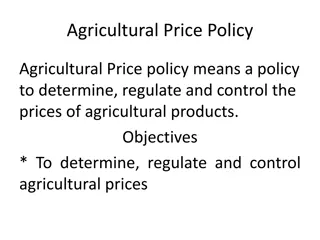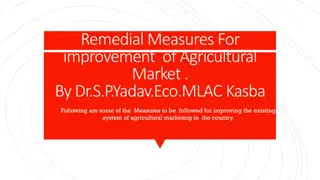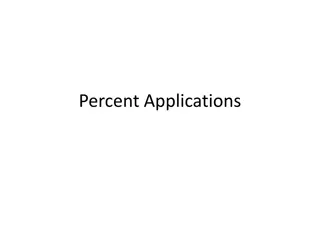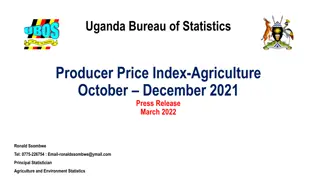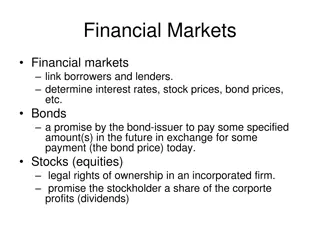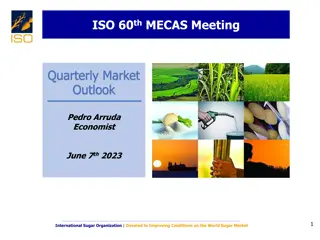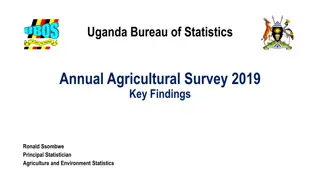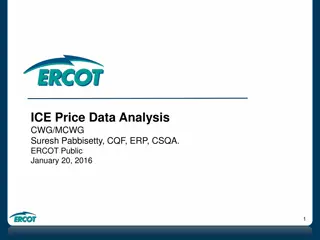
Agricultural Prices and Policy
Learn about the significance of agricultural prices, how they influence production decisions, resource allocation, and help maintain a balance between demand and supply in the agricultural sector. Explore the functions of prices in guiding both producers and consumers in economic systems.
Download Presentation

Please find below an Image/Link to download the presentation.
The content on the website is provided AS IS for your information and personal use only. It may not be sold, licensed, or shared on other websites without obtaining consent from the author. If you encounter any issues during the download, it is possible that the publisher has removed the file from their server.
You are allowed to download the files provided on this website for personal or commercial use, subject to the condition that they are used lawfully. All files are the property of their respective owners.
The content on the website is provided AS IS for your information and personal use only. It may not be sold, licensed, or shared on other websites without obtaining consent from the author.
E N D
Presentation Transcript
Agricultural Prices and Agricultural Prices and Policy Policy
Meaning ofAgricultural Prices Consumers go to the market in order to purchase the required commodities. In the process of purchasing, consumers pay for the value of the commodity in terms of currency units of the nation. Price of the commodity refers to the value of the goods in terms of money units. Prior to evolution of money, goods were exchanged, one for the other depending on the needs of the people. This process of marketing is known as barter system. Barter system was replaced with the advent of money.
FUNCTIONS OF PRICES 1. What and How Much to Produce In the competitive economic system prices of the commodities give signals to the producers regarding the type and quantity of commodity to be produced in particular place at a particular point of time. Consumers are guided by the prices of the commodities and plan their purchases from the given income, so as to maintain their desired levels of living. Thus, the directions given by the prices vary according to various groups of consumers and producers. For example, in a situation of inflation, producers would get higher incentives to produce the required quantities at higher magnitude. On the contrary, consumers with fixed income have to cut down the consumption levels because of high prices. The reverse situation would result in the periods of deflation i.e., falling prices.
2. How to Produce Prices play an important role in deciding methods of production. Every producer aims at producing a commodity, with efficient methods of production. A process of production is efficient when a given amount of output is produced with minimum cost. The choice of resources depends on their relative prices. Producer uses mo expensive resources in smaller quantities and less expensive resources in larger amounts. If labour is cheap, adoption of labour-intensive technology contributes to the least cost production. On the other hand, adoption of capital-intensive technology results in minimization, when it is available in abundant quantities. The producers who fail to adopt least cost methods of production find it difficult to survive in the business.
3. Prices Serve Basis for Allocation of Resources in the Production Process Employment of scarce resources viz., land, labour, capital, water, etc., are to be directed for producing the commodities, which are having higher price. If this is not followed it results in losses in the production, particularly when the economy is in inflation. This is to say that high value commodities should be produced so as to sustain in the process of production. 4. Prices Help to Strike a Balance between Demand and Supply This means when the demand is more than the supply, prices would give incentives to the producers. Similarly when the supply is more than the demand prices are brought down to lower level.
5. Prices Help the Consumers to Allocate their Income in the Purchase of Goods and Services In purchasing the commodities consumers seek to maximize satisfaction from the given level of income. The low income consumers spend higher proportion of their income on necessaries i.e., food, clothing, etc., and they spend relatively less income on luxuries or manufactured goods like transistors, TVs, etc. But at higher level of their income, the proportion of income spent on necessaries decreases. This is the Engel's law of family consumption. Similarly, when relative prices of commodities are changing, low-income groups prefer low priced goods. Only high-income groups do have a preference to luxuries. Thus, the relative prices of the commodity help to allocate the consumers' income on different goods, which are having varying relative prices. Prices affect the transfer of income from the farm sector to non-farm sector through terms of trade."
6. Distribution of Income among Different Groups of Farmers Marketable surplus would be high with the large farmers relative to small farmers. If there is a price rise for agricultural commodities, large farmers with substantial marketable surplus would be more benefited by the price rise of the commodity compared to small farmers with low marketable surplus. 7. Movement of Commodities over Time and Place Transportation of commodities from one area to another area i.e., from surplus area to deficit area takes place due to changes in the price. As commodities are produced based on agro climatic characteristics and seasons, there is a great need for marketing of the commodities over space and time due to price differential and consumption needs. This is to say that commodities are transported to deficit areas and the movement and magnitude of goods is regulated by the price differentials and transport costs.
8. Capital Formation inAgriculture Prices affect capital formation in agriculture, industries and allied sectors. They also affect the production potential of these goods in the long run. Higher prices for farm products lead to increased value of farm output. Consequently farm investment increases and with the increased investment, there will be further increase in the value of farm output and this further leads to higher consumption and standard of living. Thus, capital formation takes place through accelerator and multiplier effect. Farm workers demand higher wages when prices are increased. This inturn squeezes farm profit and lowers the incentives to the farmers. On the other hand, the increased value of farm output would lead to investment in the non-farm sector partly. Thus capital formation would also take place in the non-farm sector.
9. High Prices and Inflation If the prices are persistently increasing, it leads to inflationary trends in the economy. As a result, a large number of economic variables like per capita income, per capita consumption, employment, real wages, interest rate policies, etc., are very much affected by the price rise. 10. Monetary and Fiscal Policies When prices are changing we require appropriate monetary and fiscal policies to be formulated in the economy. The policies related to money supply, interest rates, deficit financing, direct and indirect taxes, subsidies, levies, quotas, etc., are to be regulated when prices are fluctuating widely in the economy.
Administered Prices An Administered Price is the price of a good or service as dictated by a government or centralized authority, as opposed to market forces of supply and demand. The concept of Administered Price was first introduced by famous British Economist, John Maynard Keynes for the prices charged by a monopolist. A monopolist can be a price maker and he consciously administered the price of his product irrespective of the cost of production. However, in India the meaning of Administered Price has been quite different. In India, Administered Prices refer to prices which are fixed and enforced by the Government. They acquire a statutory nature. They are the outcome of the price policy of the Government. The Government interferes in the price mechanism and fixes minimum and maximum prices of various commodities in the agricultural and non- agricultural sectors.
Procurement Price It is the price at which the Government procures commodities from farmers/ processors to feed public distribution system and maintain buffer stocks. However, the Government through the policy instrument of procurement prices is imposing an element of compulsion on the farmers to sell part of their produce to the Government at the announced procurement price. Ceiling Price Ceiling price is an upper price level of a commodity fixed by the Government to protect the consumers from unwarranted price rise. By fixing ceiling price Government checks the traders in charging a higher price than the maximum price. It does not apply to the farmers.
Minimum Support Price (MSP) It is fixed based on average cost of production. This is mainly aimed at protecting the farmers against the price fall during surplus production or market glut conditions. MSP is announced by the Government of India ahead of the agricultural seasons every year. The minimum support price is the price at which the Government of India makes a commitment to purchase all the quantities offered by the farmers. But in reality MSP is always lower than the market price for foodgrains, as such the farmers are not obliged to sell their products to the Government.
Need forAgricultural Price Policy The basic aim of agricultural price policy is the intervention in the agricultural produce markets to influence the price levels and their fluctuations, particularly from farm gate to retail level. Price policy is directed to bring about growth and equity in the country, therefore it is occupying a prime place in economic and political debate it involves conflicting objectives.
Agricultural Prices Commission (APC) was set up in January 1965 with a broad framework of price policies. It was renamed as Commission for Agricultural Costs and Prices (CACP) in the year 1985. The need for agricultural price policy was clearly identified due to the following factors. Agricultural prices fluctuate more violently than the prices of industrial products. Price fluctuations bring disaster to producers as well as consumers. Middlemen take undue advantage and exploit the rest of the population through speculation. Price fluctuations retard economic development of the nation. Price fluctuations affect the welfare of the consumers. During inflation the low-income group of consumers will be very much affected because most goods will not be with in the accessible reach of the consumers because of high prices.





